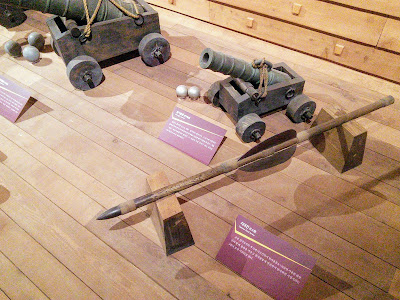Part IV of the collection is a survey of the various artillery systems employed by the Koreans. This includes the famous Hwacha (listed as the Shin-Ki Jeon from the Perry Miniatures site.) and the Hwago artillery piece.
 |
| Hwa Cha from the Museum |
The Hwacha is a bottle rocket launcher on steroids, essentially ripple firing long, explosive tipped arrows.
 |
| Hwa Ho and Hwa Cha |
 |
| Hwa Go up close |
The Hwago is a similar system but is more of an organ-gun with 50 short gun barrels loaded with three metal darts each.
 |
| Hwa Go from Jinjuseong fortress |
 |
| Hwa Cha from Jinjuseong fortress |
One of the interesting features of Korean cannon is the variety of projectiles. Rather than just using stone or metal cannon balls, many fired a steel capped wooden dart. Cannon were used both on Korean war
 |
| A collection of Naval pieces in a mock-up of a Korean Warship. |
 |
| Part of a mural depicting a fight between Korean garrison troops and the Japanese. You can see a mix of artillery pieces. |
 |
| Smaller field piece |
 |
| Similar Rockets from Jinjuseong Fortress |
 |
| Collection of pieces from Jinjuseong fortress museum. Note the small mortar in the back. |
 |
| Demonstration cannon from Suwon Palace grounds. |
Finally, there were multiple examples of heavier artillery pieces from the various fortresses and later periods.
 |
| Display from the museum |
 |
| More museum pieces |
 |
| A later (18th -19th C?) howitzer |
 |
| Gun display at Suwon fortress |
 |
| The fields of fire have changed significantly since the 16th century. |




Impressive examples of artillery, thanks for sharing!
ReplyDeleteJust trying to make life easier for the next guy.
DeleteQuite a variety of ordnance there, Jake. Many have European analogues, but all seem just sufficiently "different" to be distinctive.
ReplyDeleteFrom what I have found, most of the similarities are based on the adoption of early European models that were then adapted for local manufacture. (Many cases for this with the Japanese.)
DeleteInteresting collection of artillery. With most of those large rockets sticking out of the gun barrel, I wonder how stable the projectile was once fired?
ReplyDeleteI guess it's "fin stabilized." It does seem odd in light of the usual reliance on small round projectiles.
Delete